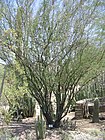Note: This is a project under development. The articles on this wiki are just being initiated and broadly incomplete. You can Help creating new pages.
Difference between revisions of "Acacia farnesiana - Vitkhadira"
(→External Links) |
(→Mode of Propagation) |
||
| Line 51: | Line 51: | ||
==Where to get the saplings== | ==Where to get the saplings== | ||
==Mode of Propagation== | ==Mode of Propagation== | ||
| − | {{Propagation|Seeds}} | + | {{Propagation|Seeds}} |
==How to plant/cultivate== | ==How to plant/cultivate== | ||
Revision as of 10:45, 1 June 2019
Vitkhadira is a small, spiny, much-branched, deciduous shrub or tree with a wide, low crown; it can grow 2 - 7 metres tall. The short, crooked bole can be 15 - 35cm in diameter. The plant can form dense, spiny thickets. A multipurpose tree with a wide range of uses as a food, medicine, perfume and source of materials.
Contents
[hide]- 1 Uses
- 2 Parts Used
- 3 Chemical Composition
- 4 Common names
- 5 Properties
- 6 Habit
- 7 Identification
- 8 List of Ayurvedic medicine in which the herb is used
- 9 Where to get the saplings
- 10 Mode of Propagation
- 11 How to plant/cultivate
- 12 Commonly seen growing in areas
- 13 Photo Gallery
- 14 References
- 15 External Links
Uses
Oral problems, Diarrhea, Inflammation, Cough, Itching, Urinary tract disorders [1]
Parts Used
Chemical Composition
Common names
| Language | Common name |
|---|---|
| Kannada | byadala gida, jaali, kashturi, karijali, kasturi jaali |
| Hindi | durgandhakhair, gandhi-babul, guhbabul, pissibabul |
| Malayalam | kariveelum, pauvelam, pikharu-vil |
| Tamil | arimetam, kacappuppivelamaram, kasturivel, kirimetam, peyvel |
| Telugu | arimidamu, kampu tumma, kasthoori thumma, murikitumma, piyyathumma |
| Marathi | NA |
| Gujarathi | NA |
| Punjabi | NA |
| Kashmiri | NA |
| Sanskrit | arimedah, godhaskanda, kalaskandha, Vitkhadir |
| English | cassie |
Properties
Reference: Dravya - Substance, Rasa - Taste, Guna - Qualities, Veerya - Potency, Vipaka - Post-digesion effect, Karma - Pharmacological activity, Prabhava - Therepeutics.
Dravya
Rasa
Tikta (Bitter), Kashaya (Astringent)
Guna
Laghu (Light), Rooksha (Dry)
Veerya
Sheeta (cold)
Vipaka
Katu (Pungent)
Karma
Pitta, Kapha
Prabhava
Habit
Identification
Leaf
| Kind | Shape | Feature |
|---|---|---|
| Bipinnate | alternate | Leaves ca. 5 in a cluster, 2-7 cm; pinnae 5 pairs, 1-2.5 cm; leaflets 10-15 pairs, elliptic, 5 x 1 mm, overlapping, glabrous, base truncate, margin entire, apex obtuse; nerves prominent below; petiole to 1.5 cm, with a gland near the middle; rachis stiff-pubescent, eglandular; stipular thorns unequal, to 2 cm, straight. |
Flower
| Type | Size | Color and composition | Stamen | More information |
|---|---|---|---|---|
| Bisexual | axillary globose heads | yellow | Many | Flower-heads globose, 8 mm across, 2 or 3 in axillary cluster, to 2 cm; peduncle densely stiff-pubescent, with involucel of bracteoles at the base. Flowers 2 mm across. Calyx-tube 5-toothed, to 1.5 mm. Petals 5, yellow, to 2 mm. Stamens numerous, to 4 mm, basally connate. Ovary stipitate, terete, to 1 mm; style to 3 mm. |
Fruit
| Type | Size | Mass | Appearance | Seeds | More information |
|---|---|---|---|---|---|
| A Pod | 5 x 0.5 cm | pulpy, turgid, glabrous, obtuse at apices, horned | seeds 20 or more, globose, 0.5 mm, 2-seriate. | {{{6}}} |
Other features
List of Ayurvedic medicine in which the herb is used
Where to get the saplings
Mode of Propagation
How to plant/cultivate
Season to grow
Soil type
Propagation
Commonly seen growing in areas
Tropical area, Sub tropical areas.
Photo Gallery
References
External Links
- Ayurvedic Herbs known to be helpful to treat Oral problems
- Ayurvedic Herbs known to be helpful to treat Diarrhea
- Ayurvedic Herbs known to be helpful to treat Inflammation
- Ayurvedic Herbs known to be helpful to treat Cough
- Ayurvedic Herbs known to be helpful to treat Itching
- Ayurvedic Herbs known to be helpful to treat Urinary tract disorders
- Herbs with Stem used in medicine
- Herbs with Bark used in medicine
- Herbs with Heartwood used in medicine
- Herbs with common name in Kannada
- Herbs with common name in Hindi
- Herbs with common name in Malayalam
- Herbs with common name in Tamil
- Herbs with common name in Telugu
- Herbs with common name in Sanskrit
- Herbs with common name in English
- Habit - Shrub or small tree
- Index of Plants which can be propagated by Seeds
- Herbs that are commonly seen in the region of Tropical area
- Herbs that are commonly seen in the region of Sub tropical areas
- Herbs
- Shrub
- Fabaceae




